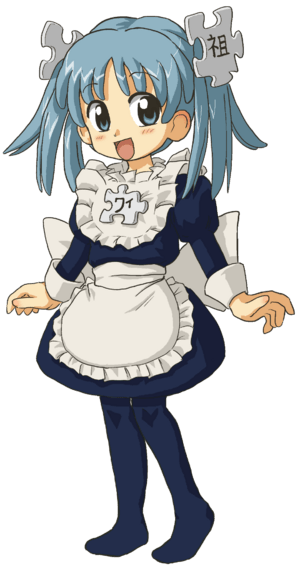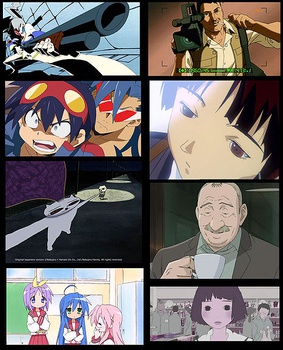Anime facts for kids
Anime (pronounced "AH-nee-may") is a special kind of animation that comes from Japan. It can be drawn by hand or made using computers. When people outside Japan talk about "anime," they usually mean animation made in Japan. But in Japan, the word "anime" is short for "animation" and means any animated show or movie, no matter where it's from!
The very first Japanese animation for people to watch was made in 1917. A unique art style for anime became popular in the 1960s. This was thanks to the work of a famous artist named Osamu Tezuka. Over time, more and more people in Japan started watching anime. Many anime stories come from Japanese comics called manga, or from light novels and video games. Anime has many different types of stories, called genres, for all kinds of viewers.
Making modern anime involves several steps. These include planning the story with storyboards, having voice actors speak the lines, designing the characters, and creating the animation frames. Since the 1990s, animators have used more computer animation to help make anime faster and better.
Popular anime and manga stories are often translated into other languages. This means the words are changed so people in different countries can understand and enjoy them.
Contents
The Story of Anime
The history of anime began around 1900. At that time, Japanese filmmakers started trying out new ways to make animated movies. This was happening at the same time as filmmakers in places like the United States, Russia, Germany, and France.
Japanese filmmakers didn't have a lot of money or many places to film their movies. It was also hard to find actors for stories set in other parts of the world. Japanese people look different from people in other countries. Filmmakers liked animation because artists could draw any place or person they imagined. This allowed animators to be very creative with their cartoons.
During the 1970s, manga became very popular. Because of this, many anime shows started as manga stories. Animators would take the drawings and stories from a manga artist and turn them into an anime. During this time, Osamu Tezuka became super famous. People now call him a "legend" and the "god of manga." Tezuka and other early anime creators made many of the story types and styles we see in anime today.
For example, the giant robot genre, known as "mecha" outside Japan, started with Tezuka's ideas. Robot anime like Gundam and Macross became classic shows in the 1980s. Today, robot anime is still very popular in Japan and around the world. In the 1980s, anime became very popular in Japan, and more shows were made. (Though Manga is even more popular than anime in Japan!)
What Makes Anime Unique?
Anime is different from other types of animation because of its art styles and how it's made. Visually, anime shows have many different art styles. These styles change depending on the creators, artists, and studios. While there isn't one single art style for all anime, they do share some similar ways of animating and designing characters.
Anime often uses "limited animation." This means that not every single movement is drawn. Sometimes, characters might have flat expressions, or time might seem to pause. Anime also covers many different topics and stories. It can even include real historical figures. Anime stories often have complex plots.
A special part of anime is its unique drawing style. Characters often have large, oval eyes with clear lines. They also have bright colors and their mouths move very little when they talk.
How Anime is Made
Modern anime follows a common way of being produced. This includes creating storyboards (like a comic book version of the show), having voice acting, designing the characters, and making the animation frames. Since the 1990s, animators have used more computer animation to make the process faster.
Early anime was more experimental. It included drawings on blackboards, stop motion animation with paper cutouts, and silhouette animation. Later, "cel animation" became very popular. This is where drawings are made on clear plastic sheets called cels. In the 21st century, other animation methods are mostly used for independent short films.
Computers started being used in animation in the 1990s. Movies like Ghost in the Shell and Princess Mononoke mixed cel animation with computer-made images. When a big company stopped making cels, it made the industry switch to digital methods even faster.
Before computers, anime was made using traditional methods. Animators would draw key poses, and then fill in the movements between them. Most mainstream anime uses fewer main drawings and more "in-between" drawings.
Japanese animation studios were pioneers in using "limited animation" techniques. These techniques give anime its special look. Unlike Disney animation, which focuses a lot on smooth movement, anime often focuses on the quality of the art. Limited animation helps save time and can also be used as an artistic choice.
Anime scenes often try to look three-dimensional. The backgrounds are very important for creating the mood of the show. Sometimes, these backgrounds are not invented. They are based on real places, like in Howl's Moving Castle and The Mel melancholy of Haruhi Suzumiya.
Anime also uses cinematic effects, like a movie camera. This includes panning (moving the camera side to side), zooming in, and different camera angles. These dynamic shots would be hard to create in real life. In anime, the animation is usually finished before the voice acting is recorded. This is different from American animation, where voice acting often comes first.
Anime Characters
The human characters in anime usually have body shapes that look like real human bodies. Artists often use the height of the head as a basic measurement for body parts. Most anime characters are about seven to eight heads tall. However, anime artists sometimes change body shapes on purpose. They might make "super deformed" characters, who have very small bodies compared to their heads. Many super deformed characters are only two to four heads tall.

A common thing you'll see in anime character design is very large eyes.
Hair in anime is often super lively and colorful, or styled in unique ways.
Anime and manga artists often use common facial expressions to show feelings. For example, you might see sweat drops to show nervousness. Red cheeks can mean embarrassment, and glowing eyes can show an intense stare.
Types of Anime
- Kodomo (for young children)
- Shonen (for boys)
- Shojo (for girls)
- Seinen (for adult men)
- Josei (for adult women)
Related pages
Images for kids
-
Akihabara in Tokyo is a popular place for anime and manga fans.
See also
 In Spanish: Anime para niños
In Spanish: Anime para niños






